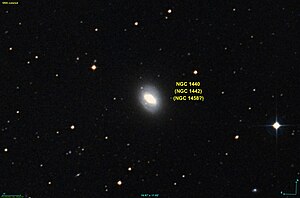NGC 1440
| Galaxy NGC 1440 / NGC 1442 |
|
|---|---|

|
|
| AladinLite | |
| Constellation | Eridanus |
|
Position equinox : J2000.0 , epoch : J2000.0 |
|
| Right ascension | 03 h 45 m 02.9 s |
| declination | -18 ° 15 ′ 58 ″ |
| Appearance | |
| Morphological type | (L) SB (rs) 0 ^ + |
| Brightness (visual) | 11.6 mag |
| Brightness (B-band) | 12.6 mag |
| Angular expansion | 2.2 ′ × 1.6 ′ |
| Position angle | 28 ° |
| Surface brightness | 12.8 mag / arcmin² |
| Physical data | |
| Affiliation | Eridanus group SSRS group 72 NGC 1400 group NGC 1407 group LGG 100 |
| Redshift | 0.005327 ± 0.000090 |
| Radial velocity | 1597 ± 27 km / s |
|
Stroke distance v rad / H 0 |
(68 ± 5) x 10 6 ly (20.7 ± 1.5) Mpc |
| history | |
| discovery | William Herschel |
| Discovery date | October 6, 1785 |
| Catalog names | |
| NGC 1440 • 1442 • PGC 13752 • ESO 549-010 • MCG -03-10-043 • 2MASX J03450290-1815577 • SGC 034248-1825.4 • GC 773/774 • H II 458 / II 594 • h 2583 • GALEX ASC J034502. 90-181600.5 • LDCE 251 NED049 | |
NGC 1440 = NGC 1442 is a lenticular galaxy of the Hubble type SB0 in the constellation Eridanus in the southern sky . It is estimated to be 68 million light years from the Milky Way and about 45,000 light years across . The galaxy is considered a member of the Eridanus Galaxy Cluster and the NGC 1407 group, or LGG 100 .
The galaxies NGC 1452 and IC 345 are located in the same area of the sky .
The object was discovered by Wilhelm Herschel on October 6, 1785 . This galaxy was also likely observed by the American astronomer Francis Leavenworth in 1886 and listed in the New General Catalog under the symbol NGC 1458.
